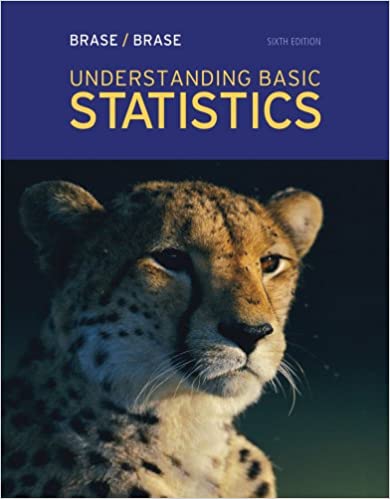
Understanding Basic Statistics 6th Edition by Charles Henry Brase,Corrinne Pellillo Brase
Edition 6ISBN: 978-1111827021
Understanding Basic Statistics 6th Edition by Charles Henry Brase,Corrinne Pellillo Brase
Edition 6ISBN: 978-1111827021 Exercise 52
Please provide the following information for Problems 11-22, part (a):
(i) What is the level of significance State the null and alternate hypotheses.
(ii) Check Requirements What sampling distribution will you use What assumptions are you making What is the value of the sample test statistic
(iii) Find (or estimate) the P -value. Sketch the sampling distribution and show the area corresponding to the P -value.
(iv) Based on your answers in parts (i) - (iii), will you reject or fail to reject the null hypothesis Are the data statistically significant at level a
(v) Interpret your conclusion in the context of the application.
Note: For degrees of freedom d.f. not in the Student's t table, use the closest d.f. that is smaller. In some situations, this choice of d.f. may increase the P -value a small amount, and therefore produce a slightly more "conservative" answer.
Answers may vary due to rounding.
Medical: REM Sleep REM (rapid eye movement) sleep is sleep during which most dreams occur. Each night a person has both REM and non-REM sleep. However, it is thought that children have more REM sleep than adults (Reference: Secrets of sleep by Dr. A. Borbély). Assume that REM sleep time is normally distributed for both children and adults. A random sample of n 1 = 10 children (9 years old) showed that they had an average REM sleep time of
 hours per night. From previous studies, it is known that 1 = 0.5 hour. Another random sample of n 2 = 10 adults showed that they had an average REM sleep time of
hours per night. From previous studies, it is known that 1 = 0.5 hour. Another random sample of n 2 = 10 adults showed that they had an average REM sleep time of
 hours per night. Previous studies show that 2 = 0.7 hour.
hours per night. Previous studies show that 2 = 0.7 hour.
(a) Do these data indicate that, on average, children tend to have more REM sleep than adults Use a 1 % level of significance.
(b) Find a 98% confidence interval for 1 2. Explain the meaning of the confidence interval in the context of the problem.
(i) What is the level of significance State the null and alternate hypotheses.
(ii) Check Requirements What sampling distribution will you use What assumptions are you making What is the value of the sample test statistic
(iii) Find (or estimate) the P -value. Sketch the sampling distribution and show the area corresponding to the P -value.
(iv) Based on your answers in parts (i) - (iii), will you reject or fail to reject the null hypothesis Are the data statistically significant at level a
(v) Interpret your conclusion in the context of the application.
Note: For degrees of freedom d.f. not in the Student's t table, use the closest d.f. that is smaller. In some situations, this choice of d.f. may increase the P -value a small amount, and therefore produce a slightly more "conservative" answer.
Answers may vary due to rounding.
Medical: REM Sleep REM (rapid eye movement) sleep is sleep during which most dreams occur. Each night a person has both REM and non-REM sleep. However, it is thought that children have more REM sleep than adults (Reference: Secrets of sleep by Dr. A. Borbély). Assume that REM sleep time is normally distributed for both children and adults. A random sample of n 1 = 10 children (9 years old) showed that they had an average REM sleep time of
 hours per night. From previous studies, it is known that 1 = 0.5 hour. Another random sample of n 2 = 10 adults showed that they had an average REM sleep time of
hours per night. From previous studies, it is known that 1 = 0.5 hour. Another random sample of n 2 = 10 adults showed that they had an average REM sleep time of  hours per night. Previous studies show that 2 = 0.7 hour.
hours per night. Previous studies show that 2 = 0.7 hour.(a) Do these data indicate that, on average, children tend to have more REM sleep than adults Use a 1 % level of significance.
(b) Find a 98% confidence interval for 1 2. Explain the meaning of the confidence interval in the context of the problem.
Explanation
(a)
Let
and
be the means of the di...
Understanding Basic Statistics 6th Edition by Charles Henry Brase,Corrinne Pellillo Brase
Why don’t you like this exercise?
Other Minimum 8 character and maximum 255 character
Character 255


